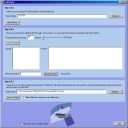I’ve written a program I call CardSharkV (the V is short for Vista) that helps you download pictures from your digital camera’s memory card. Does the world really need another one of these? Probably not. But this one has a little twist.
Download CardSharkV installer (or the installer in a zip file). Once it’s downloaded, double click the SetupCardSharkV.msi file (or unzip the SetupCardSharkV.zip file and then double click the unzipped SetupCardSharkV.msi file.)
How it works
It groups pictures for you based on how far apart, timewise, they were taken. I came up with this grouping method based on how I tend to organize my own photos into folders on my hard drive (way before Apple came out with their iPhoto 08 “Event” feature, by the way). I don’t want the way I organize photos to be managed by some application, however convenient that might be. The application’s database might get corrupted, or I might switch to a different application down the road. So I want my photos to be organized right in the file system.
Here’s how CardSharkV organizes photos. It groups photos and creates folder structures based on the times the photos were taken. The structure looks like this:
[parent path]\2007\2007_05\16 Group01
Each folder contains the jpg files that belong to that group. You get to adjust the “gap” time between groups, and you get to see thumbnails of the photos that go into the group before you tell the program to copy the photos from the card to the hard drive. You can also name the groups something more meaningful than “Group01”.
Screenshots
When I first posted this page, I completely forgot that you might want to see some screenshots before even downloading the program and trying it out. So I’m now fixing that, and posting these shots, so you don’t have to imagine how the program looks and works.
![]()
This is the icon. A scary shark snapping up an SD-card. Yes, it’s silly.

This is the screen that lets you pick where your pictures are. The location is remembered from run to run.

Here the program is looking through the pictures, building groups and thumbnails along the way.

Here is the result of the grouping. You can rename groups as you’ll see in the next shot.

Here a group has been renamed.

This is where you pick the destination for your grouped pictures. You can also instruct the program to delete the files from the source once they’re copied.

Here’s the process of copying the grouped pictures in progress.
For people who don’t like wizard-like user interfaces, there’s also a “crowded” mode, which lets you do all steps in one window (note that this is not the default mode):
I hope this gives you an impression of how the program works and what it looks like. These screenshots are taken on an XP machine, but things will look very similar on Vista.
Licensing
I’m carging a modest fee of $5 for a license to use the program. There is a mechanism built into CardSharkV that lets you request a license file. The only information I need to generate a license for you, is that you tell me the machine name that you want to run CardSharkV on. The mechanism in the program pulls that name out for you when you click a button. At the same time, it generates an email message containing the machine name. After you send the email, head over to www.paypal.com and send $5 to _geektieguy at geektieguy dot com_. Once I see the payment, I’ll email back a license file that you can drag and drop into a field in CardSharkV to enable the final step (actually copying your pictures using the grouping you’ve set up).
P.S.: This is my first attempt at producing software that I’ll charge money for. I’ve published a program before that I released as freeware, while encouraging donations via PayPal. Last time I counted I had over 28.000 downloads of that program. Out of those over 28.000 downloads I’ve had two people donate money. Had I charged just $5 per copy, I could have had a nice on-the-side income. No doubt, the price would have turned off a lot of people. So, like they say in financial circles, “past performance is not necessarily indicative of future results”. Also, there are the notorious “piracy” issues to consider. I don’t want to put up great barriers to usage by using complicated protection schemes like hardware dongles, but I want to encourage payment by not giving everything away for free. That being said, since this is my first attempt at charging for something I came up with, I view the whole thing as a bit of an experiment. I’m mostly in it for the experience of writing a piece of software that people might pay for.


